UV Vis spectroscopy
UV Vis spectroscopy is based on the interaction of light with matter in the UV to visible spectral range, with energy such that electronic transitions are promoted in samples. The phenomena that can observed are reflection, transmission, scattering and absorption of radiation by the material examined. The measurement of quantities to describe these phenomena allows the characterisation of samples with regard to optical properties, like refractive index, transmittance, reflectance, dielectric function.
The possibility of identifying substances by their typical characteristic absorption patterns and evaluating their concentration makes this technique very popular in industry and research in various fields (chemical, pharmaceutical, biological, agri-food…). Furthermore, the measurement of optical properties is of primary importance for the study of advanced materials, such as those used for opto-electronics, photovoltaics, and sensor technology.
In our laboratories, UV-Vis spectroscopy is a fundamental technique in research involving the study of the structure of organic and inorganic solids (using high-performance UV-Vis spectrometers), the analysis of biofluids for the study of materials for optics and optometry (with microvolume spectrometer) and the study of the chiral properties of biomolecules (via spectropolarimeter).
Our instrumentation
The Network includes a large collection of multi-equipped spectrophotometers, a spectropolarimeter for circular dichroism measurements, and a spectrophotometer for microvolume analysis.


